
Behind the calm, polite face of a Kyotoite is an angry woman who wants to shout at you for being so uncultured.
The concept of “wa” (“harmony“) is central to maintaining a peaceful society in Japan, and one of the ways it’s achieved is by understanding the culture of “tatemae” (a polite front you put on when socialising) and “honne” (saying what you really mean and feel, behind closed doors at home).
In Kyoto, a city famed for refinement and keeping old traditions alive, displays of tatemae are on a whole other level, earning a moniker of their very own, known as “ikezu“. Literally meaning “unable to go any further”, ikezu is Kyoto-speak for “mean” (as in a “mean person”) and describes the local culture for keeping others, usually those from outside Kyoto, at a distance by using expressions that conceal their true intentions.
Take the comment “You’ve got a really nice watch“, for example. While most people might feel flattered by such a compliment, if it’s someone from Kyoto saying that to you, you might want to think again because that’s Kyoto-speak for “This conversation has gone on too long.”
▼ That’s such a nice watch you should take a look at it and realise it’s time to go.
 Image: Pakutaso
Image: Pakutaso
This technique of communicating in a roundabout way has long been cultivated in the ancient capital, and it’s generally directed at “yoso-san“, the local word for people from outside the prefecture, who often don’t pick up on what’s really being said. That’s all about to change now, though, as Kyoto-based company Nai, who specialises in creating products based around “nai” (“negative“) topics like “tsumaranai” (“boring“) and “mittomonai” (“unproper“), has released a series of stickers explaining what some of these seemingly ordinary expressions really mean.
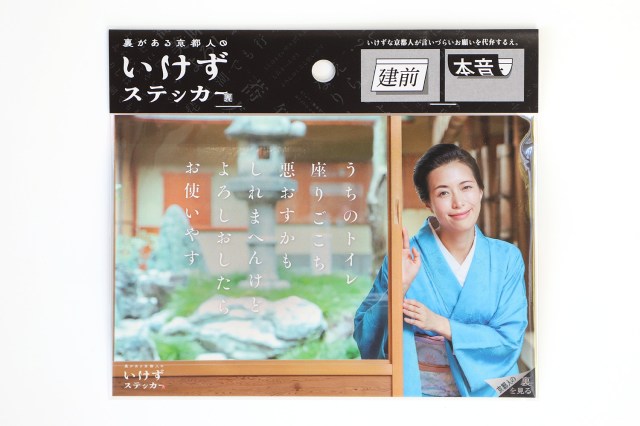
Called “Ikezu Stickers from Kyoto People with a Hidden Side“, there are four designs in the set, with each one having a front side that shows the polite expression, and a back side that shows the true meaning behind what’s being said.
On the front of the first sticker, we have a kind and warm-hearted looking woman in kimono saying, in the Kyoto dialect, “My toilet may be uncomfortable to sit on, but feel free to use it if it pleases you.”

“How nice of her to humbly offer me the use of her toilet!” You might be thinking. However, turn to the “ura” side — “ura” can be used to mean both the “reverse side” of something or “hidden side” of someone — and you’ll find what she’s really saying.
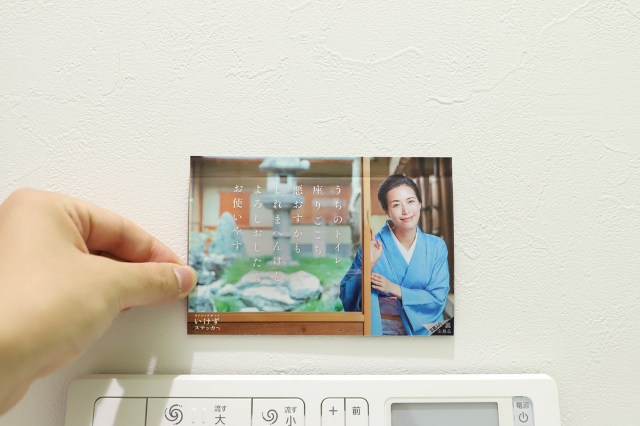
▼ “You’re not gonna stand and urinate, ok?”
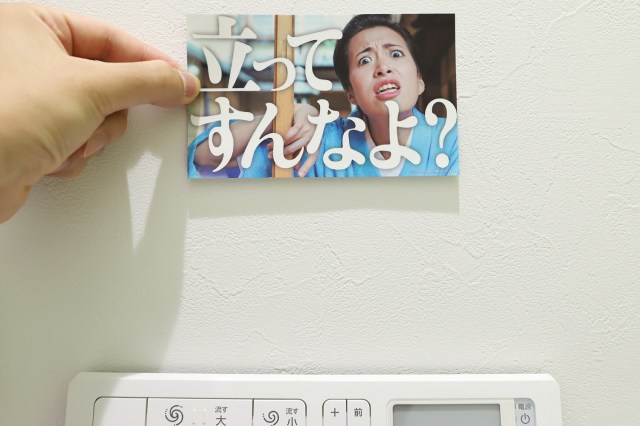
That’s a big difference in meaning that not everyone will be able to pick up on, and the look on the woman’s face says it all. The stickers have an adhesive strip on the back, making them easy to attach to places around the home where such sayings might be appropriate, and there’s even one for the mailbox that reads: “I apologise for only having a small letterbox. Sorry for your trouble.”
As you may have guessed, this is not a humble apology for the size of the mailbox. What it really means is: “Don’t stuff my mailbox with unnecessary flyers.”
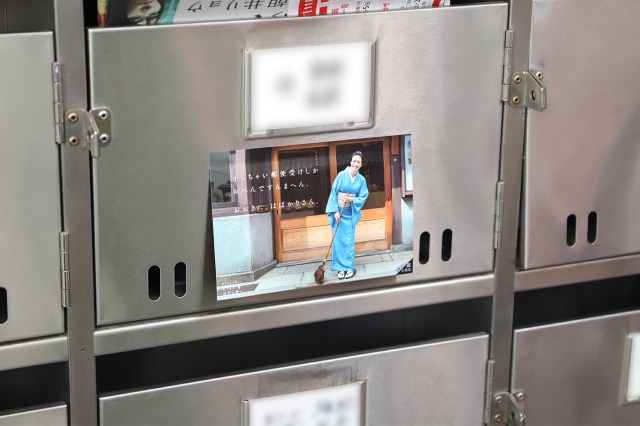
At the entrance to the home you can post this sticker, which reads, “Welcome. My, my, you’re dressed in your Sunday Best — have you been to Lake Biwa?”
Don’t be fooled by the kind smile and flattery — what she means to say is: “Don’t enter this establishment in unkempt clothes.”
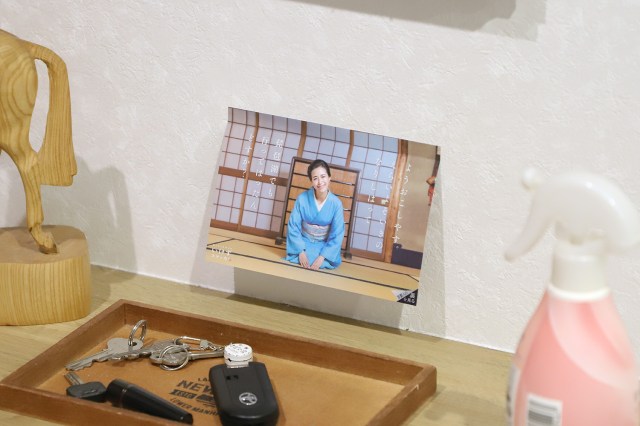
Finally, we have a message for the dining area: “Did you know? You don’t have to slurp soba noodles in Kyoto for them to be delicious.” The true meaning here is: “Don’t be a noisy eater.”

The model that appears on each of the stickers is Rie Ohnishi, who is actually the fourth-generation owner of a traditional fan shop in Kyoto. She’s gained a large following online, not only for her looks and business, but for her ability to make weird faces.
▼ This ability, combined with her background in Kyoto-style hospitality, made her the perfect model for the job.


Speaking about her work on the series, she said:
“I think everyone who was born and raised in Kyoto has been baptised with ‘ikezu’. There is a theory that ‘ikezu’ was developed to maintain good relationships in Kyoto, where it is not uncommon for people to be neighbours for hundreds of years. I used my facial muscles to the best of my ability to express the ‘ikezu’ that the people of Kyoto would relate to. I just pray that I will not be ostracised by the people of Kyoto and Shiga for this. I hope that they will view it with an open heart.”
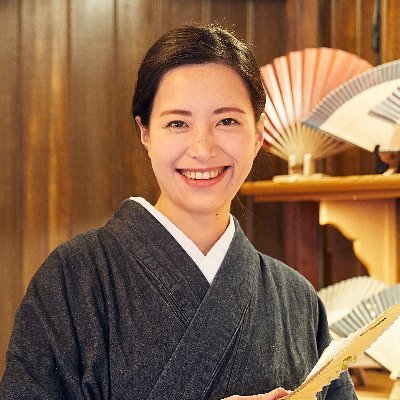
We can’t speak for the people of Kyoto, but we certainly don’t hold a grudge against Ohnishi for helping to reveal the finer details of Kyoto culture that would otherwise remain a secret amongst locals. If anyone in Kyoto does have something to say about it, though, we’re sure they’d find a roundabout way of telling her, maybe by complimenting her on her large group of friends or musical talent.
If you’d like to spread the word about ikezu, the stickers can be found at select souvenir stores in Kyoto (listed below), priced at 800 yen (US$5.35) for the set of four. While most stores will sell them on the sales floor, Ohnishi’s shop will be selling them only to customers who tell her the following secret message: “ura mo omote mo okirei dosuna” (“both the back and front are beautiful”).
Sales Locations
・Saga Arashiyama Bunkakan (11 Saga Tenryuji Mangunobaba-cho, Ukyo-ku, Kyoto City, Kyoto Prefecture 616-8385)
・Kyoto Souvenir Uramatsu (548-3 Nakano-cho, Shijo Kamiru, Shinkyogoku-dori, Nakagyo-ku, Kyoto 604-8042)
・Kaze no Eki (176-2 2F, Futagami-cho, Kamigyo-ku, Kyoto City, Kyoto Prefecture 602-0828)
・HOTEL MUSO (678 Ishifudono-cho, Shimogyo-ku, Kyoto City, Kyoto Prefecture 600-8047)
・Ryokan Koro (114 Horinoue-cho, Nakagyo-ku, Kyoto Prefecture 604-8117)
・SecondDesk Kitaoji Horikawa (14-2 Murasakino Nishigoshoda-cho, Kita-ku, Kyoto City, Kyoto 603-8165, Kyoto Prefecture)
・SHOPpeaberry (307−1 Imayakuya-cho, Kamigyo-ku, Kyoto City, Kyoto Prefecture 602-8025)
・Ohnishi Tsune Shoten (23 Hontoro-cho, Shimogyo-ku, Kyoto City, Kyoto Prefecture 600-8086 Takakura Nishi-iru)
Related: Ohnishi Tsune Shoten
Source: PR Times via Net Lab
Images: PR Times unless otherwise noted
● Want to hear about SoraNews24’s latest articles as soon as they’re published? Follow us on Facebook and Twitter!

No hay comentarios:
Publicar un comentario